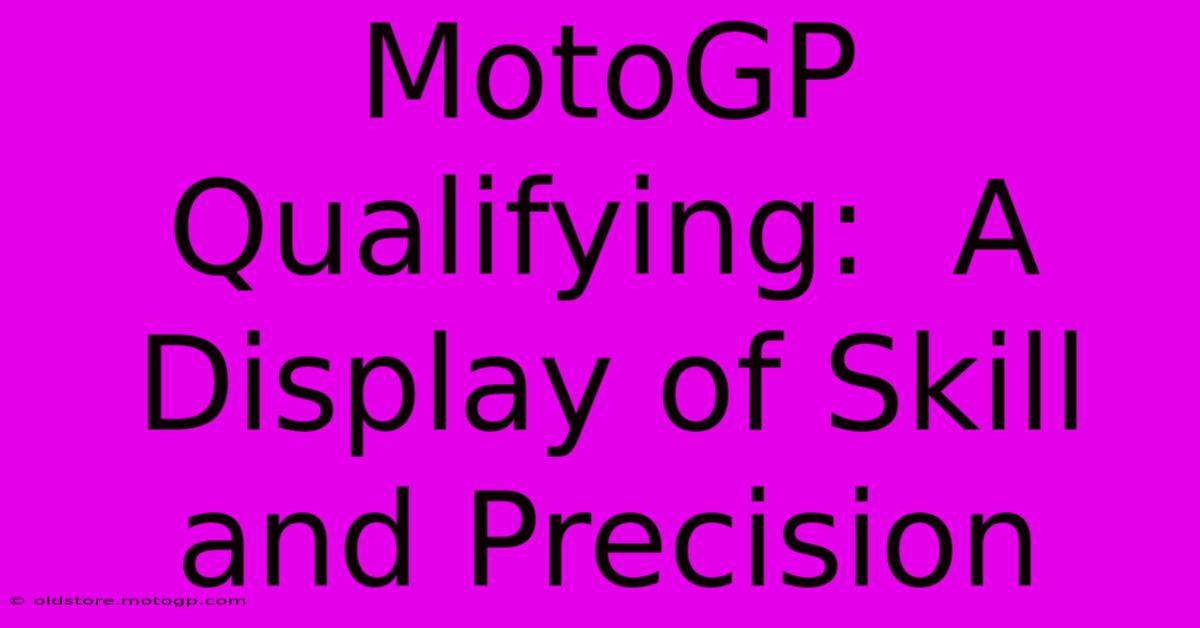MotoGP Qualifying: A Display Of Skill And Precision

Table of Contents
MotoGP Qualifying: A Display of Skill and Precision
MotoGP, the pinnacle of motorcycle racing, isn't just about the race itself. The drama, the tension, the sheer spectacle – it all culminates in the qualifying sessions. These aren't mere warm-up laps; they are a high-stakes display of skill, precision, and nerve, crucial for securing a coveted pole position and a significant advantage come race day. This article delves into the intricacies of MotoGP qualifying, exploring the strategies, the technology, and the sheer human element that makes it so captivating.
Understanding the Qualifying Format
The current MotoGP qualifying format is a multi-stage process designed to maximize excitement and reward the fastest riders. It typically unfolds as follows:
Q1 (Qualifying 1):
- The Contenders: The riders who didn't finish within the top 10 in the combined Free Practice sessions (FP1, FP2, FP3) compete here. This session is incredibly fierce, as every rider is fighting for a place in the next round.
- The Goal: The top two riders from Q1 automatically advance to Q2. The pressure is immense; one small mistake can mean the difference between a front-row start and a back-of-the-grid struggle.
Q2 (Qualifying 2):
- The Elite: The top 10 riders from the combined Free Practice sessions join the two qualifiers from Q1, making a total of 12 riders vying for pole position.
- The Stakes: This session is the ultimate showdown. Every tenth of a second counts, with riders pushing their machines and themselves to the absolute limit. The rider with the fastest lap time claims pole position, a massive advantage for the race.
The Science Behind the Speed
MotoGP qualifying isn't just about raw speed; it's a complex interplay of several key factors:
Tire Management: Choosing the right tire compound and managing its wear throughout the qualifying session is crucial. Riders and teams must balance performance with durability, considering track temperature and grip levels. A worn tire can cost valuable tenths of a second.
Aerodynamics: The aerodynamic design of the MotoGP bikes plays a critical role. Even subtle changes in bodywork can dramatically affect performance, particularly in high-speed corners. Teams meticulously fine-tune their bikes' aerodynamics to optimize speed and stability.
Electronics: Sophisticated electronic control units (ECUs) manage aspects like engine mapping, traction control, and anti-wheelie systems. Fine-tuning these settings is essential for maximizing performance without risking a crash.
Rider Skill and Technique: Ultimately, the human element remains paramount. A skilled rider can extract the maximum performance from the machine, managing tire wear, navigating corners with precision, and perfectly executing overtaking maneuvers, all under immense pressure. The mental fortitude required is as important as the physical prowess.
The Impact of Qualifying on the Race
Securing a good starting position during qualifying drastically influences the race outcome. Starting from pole position or on the front row offers significant advantages:
- Clean Air: A leading position means less congestion, reducing the risk of collisions and allowing riders to maintain a consistent pace.
- Early Momentum: A strong start can dictate the race's rhythm, allowing riders to build a gap early and potentially control the race.
- Psychological Advantage: Starting at the front provides a psychological boost, giving riders confidence and setting the tone for the rest of the race.
Beyond the Timing Screens: The Human Drama
The thrill of MotoGP qualifying extends beyond the lap times and technical aspects. It's a spectacle of human drama, with tense moments, unexpected surprises, and nail-biting finishes. The pressure is immense, with reputations and championship points on the line. The roar of the crowd, the focused intensity of the riders, and the palpable excitement make qualifying an unforgettable experience for spectators and viewers alike.
In Conclusion: MotoGP qualifying is far more than just a preamble to the main event. It's a captivating showcase of skill, precision, technology, and human drama that encapsulates the excitement and intensity of the sport. The battle for pole position is a microcosm of the entire season – a thrilling spectacle that determines the starting grid and, to a large degree, the race's outcome.

Thank you for visiting our website wich cover about MotoGP Qualifying: A Display Of Skill And Precision. We hope the information provided has been useful to you. Feel free to contact us if you have any questions or need further assistance. See you next time and dont miss to bookmark.
Featured Posts
-
Moto Gp Standings Expert Predictions And Analysis
Feb 23, 2025
-
Cota Grandstands The Ultimate Race Day Upgrade
Feb 23, 2025
-
The Hottest Us Gp Concerts This Year
Feb 23, 2025
-
Cota Parking Austin Made Easy
Feb 23, 2025
-
The Pursuit Of Perfection Moto Gp Aero Design
Feb 23, 2025
